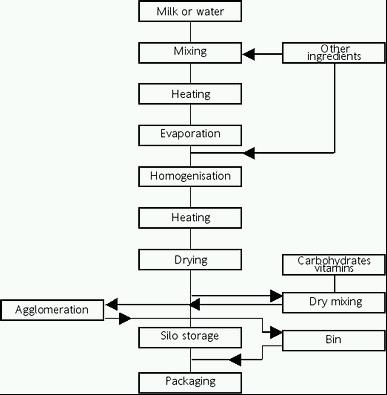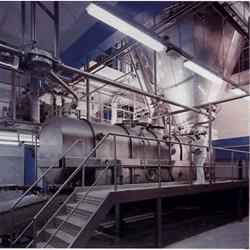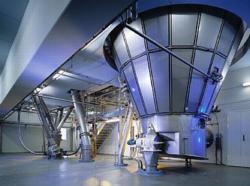Drying in baby food
Back to EFFICIENCY FINDER OF FOOD INDUSTRY
General Description
For a general overview of infant formula production, please see ‘Evaporation’ in the ‘Baby Food’ subsection.
Figure: Infant formula baby food process flow sheet
Source: http://www.spx.com/en/apv/industries/dairy/evaporated-dried/baby-food/
Drying
Drying takes place in a spray dryer system. The concentrate is atomised to droplets, using either a centrifugal or a nozzle atomiser, and it is then dried by hot air. The spray drying stage of infant formula production is key to producing a powder with a long stable shelf life.
A spray dryer system typically consists of:
- one or several high pressure nozzles or a rotary atomizer wheel for the atomization of the concentrate
- a drying chamber/tower
- an integrated fluid bed for secondary drying
- an external fluidizer
- one or several cyclone(s) and/or bag filter(s) as an air/powder separation system
- a fines return system to improve the agglomeration
When designing a spray drying plant for powder production the following must be taken into consideration:
- production time between CIP cleaning
- powder structure
- drying parameters
To order to minimise the need for cleaning, plants may include an efficient high-pressure air broom, which reduces the powder deposits in the dryer, thereby achieving prolonged running times.
Figure:Lower part of spray drying chamber and Vibro-Fluidizer® for after drying / cooling of powder. Source: GEA Niro
Figure: Spray Drying Unit. Source: GEA Niro
Application
Baby Food
Typical Parameters
The drying temperature and solids content are a high as possible In order to improve production efficiency. Product composition, however, is a decisive factor as to what parameters can be selected. In general: The drying efficiency and capacity of a spray dryer is increased by increasing the difference between the drying air and exhaust air temperature. High ambient air humidity requires a lower spray drying temperature or a dehumidification of the air, which obviously increases the production costs. Solids content prior to spray drying 45-60% Solids content after spray drying approx 97%


